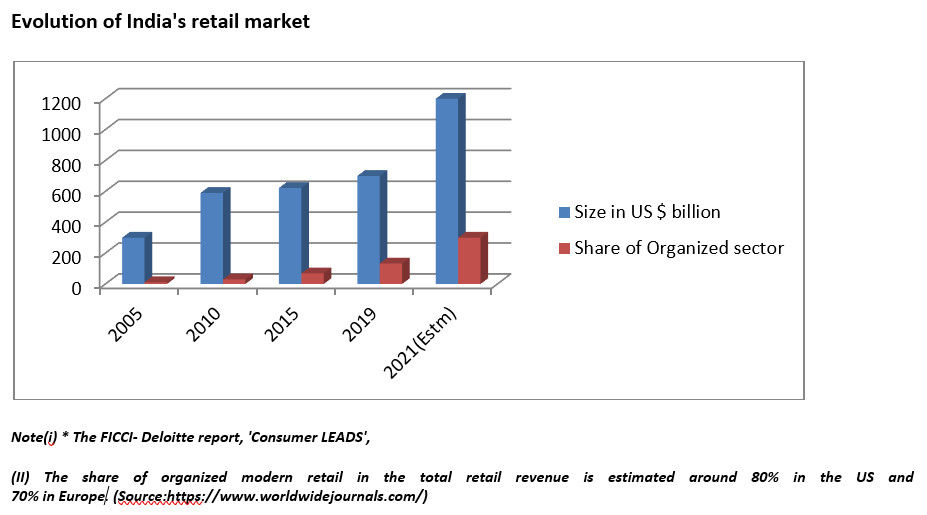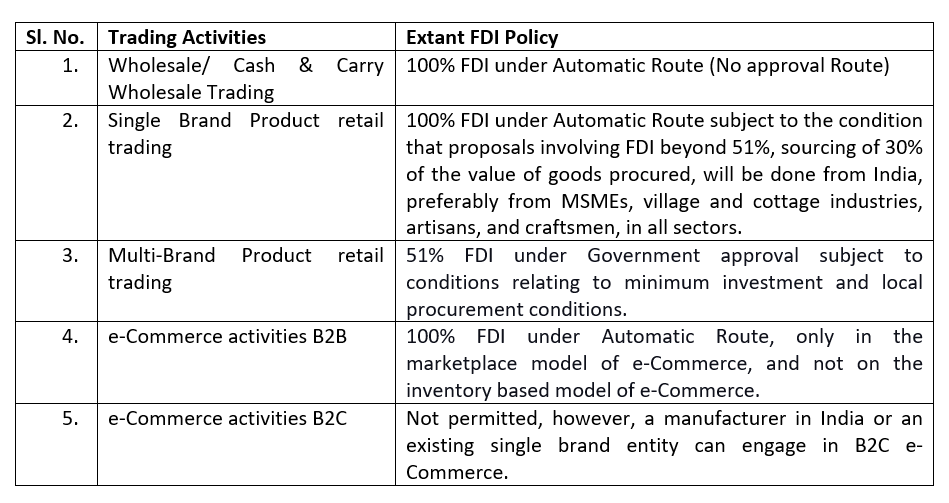
Forbes announced the list of Indian billionaires in March this year. The list saw the total number of Indian billionaires falling to 102 in 2020 compared with 106 in 2019, primarily because of the Covid-19 pandemic and the steps taken to curb its spread. The collective wealth of these billionaires shrank 23% to $313 billion during the period. But the surprise packet was one businessman who bucked the trend. Radhakishan Damani, promoter of Avenue Supermarts that operates the DMart supermarket chain, saw his assets growing by a quarter to $13.8 billion, making him India’s second-richest person after Mukesh Ambani. The tale of Damani’s rise to the top — before and during the pandemic — is a true reflection of the strength of the Indian retail industry.
In India, the retail industry is undergoing a fast transition, propelled by the structural changes brought about by the government, interest of large corporates in retailing, the change in the mindset of people, and technological advances. Though the sector is still dominated by traditional kirana stores, the entry of new players in the retail business has added dynamism and glamour to this industry. The fifth largest globally, it accounts for more than 10% of India’s GDP and nearly 8% of the country’s employment. The segment consists of traditional Kirana shops, modern organized retail outlets/ hyper markets, e-commerce (both marketplace and inventory-based), and direct selling (Amway, Tupperware, etc). The customers, especially the middle class and millennials, show a preference for the organized retail outlets for shopping.
READ I Drawing a line: Protection of personal data in a digitised world

Drivers of retail growth
Healthy economic growth coupled with the following factors since the dawn of the millennium has driven retail sector growth in India.
- Rapid urbanisation – The urban population of India is increasing. The share of urban population was 23% in 1981. It went up to 27.8% in 2001, 31.16% in 2011. According to UN estimates, 34.03% Indians lived in urban areas in 2018.
- Internet penetration – Internet penetration in India grew from 4% in 2007 to 54.29% in 2019.
- Increase in per capita income – From $425 in 1980, it has grown steady to reach $826 in 2000, $1,358 in 2010, and $2,104 in 2019.
- Easy availability of credit – From just 3.2 million in 2000, the number of credit cards soared to 22.6 million in 2007. As of 2019, India had around 52 million credit card users.
- Increasing proportion of working women resulting in higher discretionary spending – According to the PLFS survey of NSO published in May 2019, the share of regular wage/salaried workers in urban areas was 52.1 % among female workers. It is estimated that the propensity to spend in the case of working women is 1.3 times higher compared with housewives. This has resulted in more disposable income.
- Entry of corporates and foreign players – Large business houses such as Tata, Birla, and Reliance have entered the retail sector. After FDI policy was relaxed, international brands like Starbucks, Walmart, Sony, and IKEA have also entered India.
- Evolution of e-commerce – Propelled by increasing smartphone usage, 4G network, and convenience of home delivery, it is fast becoming a habit for younger generations.
- Role of media – Due to satellite television and the internet, Indian consumers are exposed to the lifestyle of other countries.
READ I Industry-university partnership key to innovation, growth
FDI in Retail Trade Sector
India kept the retail sector closed to outsiders to safeguard the livelihood of nearly 15 million small storeowners. As part of economic reforms in July 1991, FDI was permitted up to 51% in trading companies, primarily engaged in export activities. The first major relaxation was in 2006 by permitting FDI up to 51% in single brand retail, subject to government approval. The current status of FDI policy in respect of different categories of trading activities is as under:

Till June 2020, India received $2179.65 million FDI in the retail trade, mainly in single brand retail trading activities. Globally known retailers like H&M, Starbucks, Walmart, Nokia, Sony, and IKEA have established their presence in India. However, players in multi-brand retail trading are still weighing the pros and cons of the policy, and are lobbying for relaxation in conditions attached to the FDI policy, in particular for the MSME sector.
READ I Creating a world class capital goods industry in India
The entry of foreign retailers has provided the Indian consumer better shopping experiences, infused technology, and management tools for inventory management, logistics & warehousing, etc, leading to better overall efficiency in the retail sector. FDI in the sector is expected to fill a huge gap in back-end infrastructure for storage, transport, and preservation of cargo like fruits, vegetables, medical supplies that needs to be maintained at a specific temperature range. Modern cold supply chains use IoT for real-time temperature updates and alerts such as shipment location, its condition, and local weather conditions for keeping the products being transported in a specified temperature range over long distances through diverse climatic conditions.
India, the second-largest producer of fruits and vegetables, has also the dubious distinction of wasting 20% of the agricultural produce due to lack of proper storage and transportation facilities. Another sector to be benefitted from the introduction of a smart cold chain is floriculture, where India has a small share of 0.2% ($17.8 million) in 2019-20 out of a global export market of $8.5 billion. Processed meat and vaccines are now major export products from India, transport of which relies on such supply links.
e-commerce on the rise
The e-commerce industry is creating ripples in the retail sector with the entry of Amazon, Walmart and Reliance. It is forcing other segment players to adopt technological innovations to boost their business. The pandemic has changed the way the world shops. Online shopping has become not only a necessity, but also a normal practice. According to IBEF, India’s e-commerce revenue is estimated to climb from $39 billion in 2017 to $120 billion in 2020. India is a huge market with its 500+ million internet users. It has attracted big global players in the sector which are expected to provide dynamism and efficiency in the Indian retail trade network. The Narendra Modi government is currently working on e-Commerce policy and the issues in digital commerce merit a discussion.
READ I How can India correct trade imbalance with China
Government Initiatives in retail trade
In addition to the relaxation in FDI policy, other measures announced recently will have a direct bearing on the retail trade sector.
- Relaxation in Food products retail: Notwithstanding the FDI policy provisions in the trading sector, 100% FDI under the government approval route is allowed for retail trading, including e-commerce, in respect of food items produced in India. The move was aimed at providing easy market access for farmer’s products and facilitates receiving a fair price for the produce. The food and grocery sector is the largest in retailing globally. In India, it constitutes 66% of the total revenue of the retail sector.\
- The Farmers’ Produce Trade and Commerce (Promotion and Facilitation) Act: The legislation enacted in September 2020 permits intra-state and inter-state trade of farmers’ produce beyond the physical premises of Agricultural Produce Market Committee (APMC) markets and other markets notified under the state APMC Acts, and making farmers free to sell their products to anybody, anywhere. This opens up the doors for retailers including large corporate houses engaged in the retail business, and food processing companies to enter the market in a big way.
- Shifting of internal trade under business allocation to DPIIT: In January 2019, the subject covering the promotion of internal trade, including the welfare of traders and their employees; was shifted to the DPIIT under the commerce and industry ministry from the consumer affairs ministry. DPIIT which is already the nodal ministry for FDI policy will be in a better position to take a holistic view on matters like FDI in retail trade and its adverse impact on local traders. With this move, both internal trade and international trade are now under the same ministry, making it easier to take a comprehensive look at inter-linked issues.
READ I Life vs business: The ethical dilemma in the coronavirus pandemic era
Identifying issues for policymaking agenda:
By 2030, 570 million people are expected to live in Indian cities which is nearly twice the population of the United States. This, along with other demand factors, will further accelerate the growth of the retail industry in India. Once the economy stabilises after Covid-19, the demand in the rural market will provide an extra push to the next phase of growth in the retail sector. Structurally, the share of organized retail trade is expected to increase from 20% currently to 25% of the total retail trade by 2025.
The Department for Promotion of Industry and Internal Trade (DPIIT) has proposed to formulate the National Retail Policy to promote the growth of domestic trade. The objective of the proposed policy is to create a conducive environment for retail trade including simplifying rules and regulations hindering the growth of the retail sector. The policy needs to be comprehensive covering all related aspects in the retail trade space. Some of these issues are:
READ I Covid-19 will cause sharp fall in living standards, warns IMF
- Consumer protection: The fast-expanding retail sector requires a good functional regulatory environment including an effective consumer protection legal framework to provide more comprehensive rights for consumers including the right to return products purchased online within a specified period without stating any reasons.
- Level-playing field: Small traders do not have enough resources and to compete with the organized corporate business house. This will require government support for making it a level playing turf. For example, sale and discounts which used to be twice a year phenomenon in the Indian market have become a routine for e-commerce giants.
- Employment generation: To further accelerate investment flow, foreign and domestic, and thus, to create additional employment in the sector.
- Trained manpower: While generating employment is a necessity, equally important is the availability of qualified trained talent in the country. Retailers have often spoken about constraints in finding the right talent. More institutes may be encouraged to undertake not just degree courses in retail management in specialized areas like logistics, supply chain, vendor and inventory management, but also certificate courses that will train students to learn the techniques, processes, and methods required for working at the front desk in shopping malls and logistics firms.
- Storage and transportation infrastructure: India has the largest capacity of refrigerated warehousing in the world, with 150 million cubic meters, but it is mostly designed for a single commodity and lacks connectivity by the cold chain between producers, airports, food processors, and markets. There is an urgent need to upgrade existing cold storage with modern machinery, and technology.
- Street vendors: While discussing issues and challenges in retail trade activity in India, almost invariably, a large section of retail traders called street vendors are ignored. These are the persons who offer goods or services for sale to the public from a temporary static structure or mobile stall. The basic problems of street vendors are insecurity and uncertainty as their profession is considered illegal. According to the ministry of housing and urban poverty alleviation, there are approximately 10 million street vendors in India. The Supreme Court of India in 1989 held that street vendors have the right to carry out their trade and business under Article 19(1)(g) subject to reasonable restrictions. The Street Vendors (Protection of Livelihood and Regulation of Street Vending) Act, 2014 was enacted to provide security from eviction to street vendors as well as regulate street vending by demarcating street vending zones. However, action at ground level is awaited.
- Food safety: FSSAI along with bodies such as the National Restaurant Association of India may be suggested to carry out an awareness campaign, and to promote self-regulation to ensure the safety of the food sold in eateries and those by street vendors for a healthier lifestyle. Surveys conducted by state and central governments have found that a sizable percentage of the food and milk being sold in the market fail the safety test.
- Direct selling industry: India’s direct selling industry recorded sales of $2.47 billion in 2019. The department of consumer affairs issued guidelines for direct selling activities in September 2016, however, it is often felt that the direct selling sector requires a sort of legitimacy through separate legislation. The retail policy needs to take care of the regulating aspect of the segment to create an environment of trust and for protecting the legitimate rights and interests of consumers.
(Krishna Kumar Sinha is an industrial policy and FDI expert based in New Delhi. His last assignment was as an industrial adviser in the department of industrial policy and promotion, DIPP, currently known as DPIIT, under the ministry of commerce and industry of the government of India.)
Krishna Kumar Sinha is an industrial policy and FDI expert based in New Delhi. His last assignment was as an industrial adviser in the department of industrial policy and promotion, DIPP, currently known as DPIIT, under the ministry of commerce and industry of the government of India.

